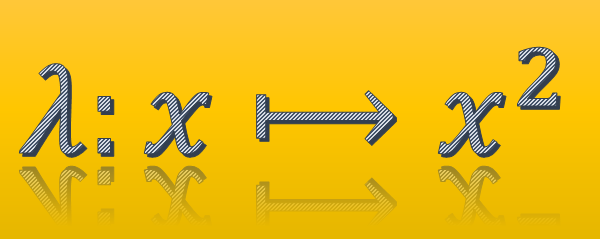快乐的Lambda表达式(二)
转载:http://www.cnblogs.com/jesse2013/p/happylambda-part2.html
快乐的Lambda表达式

上一篇 背后的故事之 - 快乐的Lambda表达式(一)我们由浅入深的分析了一下Lambda表达式。知道了它和委托以及普通方法的区别,并且通过测试对比他们之间的性能,然后我们通过IL代码深入了解了Lambda表达式,以及介绍了如何在.NET中用Lambda表达式来实现JavaScript中流行的一些模式。
今天,我们接着来看Lambda表达式在.NET中还有哪些新鲜的玩法。
Lambda表达式玩转多态
Lambda如何实现多态?我们用抽象类和虚方法了,为什么还要用Lambda这个玩意?且看下面的代码:
|
1
2
3
4
5
6
7
8
9
10
11
12
13
14
15
16
17
18
19
20
21
22
|
class MyBaseClass{ public Action
SomeAction { get; protected set;
} public MyBaseClass() { SomeAction
= () => { //Do
something! }; }}class MyInheritedClass
: MyBaseClass{ public MyInheritedClass() { SomeAction
= () => { //Do
something different! }; }} |
我们的基类不是抽象类,也没有虚方法,但是把属性通过委托的方式暴露出来,然后在子类中重新为我们的SomeAction赋予一个新的表达式。这就是我们实现多态的过程,当然父类中的SomeAction的set有protected的保护级别,不然就会被外部随易修改了。但是这还不完美,父类的SomeAction在子类中被覆盖之后,我们彻底访问不到它了,要知道真实情况是我们可以通过base来访问父类原来的方法的。接下来就是实现这个了:
|
1
2
3
4
5
6
7
8
9
10
11
12
13
14
15
16
17
18
19
20
21
22
23
24
25
26
27
28
29
|
class MyBaseClass{ public Action
SomeAction { get; private set;
} Stack<Action>
previousActions; protected void AddSomeAction(Action
newMethod) { previousActions.Push(SomeAction); SomeAction
= newMethod; } protected void RemoveSomeAction() { if(previousActions.Count
== 0) return; SomeAction
= previousActions.Pop(); } public MyBaseClass() { previousActions
= new Stack<Action>(); SomeAction
= () => { //Do
something! }; }} |
上面的代码中,我们通过AddSomeAction来实现覆盖的同时,将原来的方法保存在previousActions中。这样我们就可以保持两者同时存在了。
大家知道子类是不能覆盖父类的静态方法的,但是假设我们想实现静态方法的覆盖呢?
|
1
2
3
4
5
6
7
8
9
10
11
12
13
14
15
16
17
18
19
20
21
22
23
24
25
26
27
28
29
30
31
32
33
34
35
36
37
38
|
void Main(){ var mother
= HotDaughter.Activator().Message; //mother
= "I am the mother" var create
= new HotDaughter(); var daughter
= HotDaughter.Activator().Message; //daughter
= "I am the daughter"}class CoolMother{ public static Func<CoolMother>
Activator { get; protected set;
} //We
are only doing this to avoid NULL references! static CoolMother() { Activator
= () => new CoolMother(); } public CoolMother() { //Message
of every mother Message
= "I
am the mother"; } public string Message
{ get; protected set;
}}class HotDaughter
: CoolMother{ public HotDaughter() { //Once
this constructor has been "touched" we set the Activator ... Activator
= () => new HotDaughter(); //Message
of every daughter Message
= "I
am the daughter"; }} |
这里还是利用了将Lambda表达式作为属性,可以随时重新赋值的特点。当然这只是一个简单的示例,真实项目中并不建议大家这么去做。
方法字典
实际上这个模式我们在上一篇的返回方法中已经讲到了,只是没有这样一个名字而已,就算是一个总结吧。故事是这样的,你是不是经常会写到switch-case语句的时候觉得不够优雅?但是你又不想去整个什么工厂模式或者策略模式,那怎么样让你的代码看起来高级一点呢?
|
1
2
3
4
5
6
7
8
9
10
11
12
13
14
15
16
17
18
19
20
21
22
23
24
25
26
27
28
29
30
|
public Action
GetFinalizer(string input){ switch { case "random": return ()
=> { /*
... */ }; case "dynamic": return ()
=> { /*
... */ }; default: return ()
=> { /*
... */ }; }}//-------------------变身之后-----------------------Dictionary<string,
Action> finalizers;public void BuildFinalizers(){ finalizers
= new Dictionary<string,
Action>(); finalizers.Add("random",
() => { /*
... */ }); finalizers.Add("dynamic",
() => { /*
... */ });}public Action
GetFinalizer(string input){ if(finalizers.ContainsKey(input)) return finalizers[input]; return ()
=> { /*
... */ };} |
好像看起来是不一样了,有那么一点味道。但是一想是所有的方法都要放到那个BuildFinalizers里面,这种组织方法实在是难以接受,我们来学学插件开发的方式,让它自己去找所有我们需要的方法。
|
1
2
3
4
5
6
7
8
9
10
11
12
13
14
15
16
17
18
19
20
21
22
23
24
25
26
27
28
29
30
31
32
33
34
35
36
37
|
static Dictionary<string,
Action> finalizers;//
在静态的构造函数用调用这个方法public static void BuildFinalizers(){ finalizers
= new Dictionary<string,
Action>(); //
获得当前运行程序集下所有的类型 var types
= Assembly.GetExecutingAssembly().GetTypes(); foreach(var type in types) { //
检查类型,我们可以提前定义接口或抽象类 if(type.IsSubclassOf(typeof(MyMotherClass))) { //
获得默认无参构造函数 var m
= type.GetConstructor(Type.EmptyTypes); //
调用这个默认的无参构造函数 if(m
!= null) { var instance
= m.Invoke(null) as MyMotherClass; var name
= type.Name.Remove("Mother"); var method
= instance.MyMethod; finalizers.Add(name,
method); } } }}public Action
GetFinalizer(string input){ if(finalizers.ContainsKey(input)) return finalizers[input]; return ()
=> { /*
... */ };} |
如果要实现插件化的话,我们不光要能够加载本程序集下的方法,还要能随时甚至运行时去加载外部的方法,请继续往下看:
|
1
2
3
4
5
6
7
8
9
10
11
12
13
14
15
16
17
18
19
20
21
22
23
24
25
|
internal static void BuildInitialFinalizers(){ finalizers
= new Dictionary<string,
Action>(); LoadPlugin(Assembly.GetExecutingAssembly());}public static void LoadPlugin(Assembly
assembly){ var types
= assembly.GetTypes(); foreach(var type in types) { if(type.IsSubclassOf(typeof(MyMotherClass))) { var m
= type.GetConstructor(Type.EmptyTypes); if(m
!= null) { var instance
= m.Invoke(null) as MyMotherClass; var name
= type.Name.Remove("Mother"); var method
= instance.MyMethod; finalizers.Add(name,
method); } } }} |
现在,我们就可以用这个方法,给它指定程序集去加载我们需要的东西了。
最后留给大家一个问题,我们能写递归表达式么?下面的方法如果用表达式如何写呢?
|
1
2
3
4
5
6
7
|
int factorial(int n){ if(n
== 0) return 1; else return n
* factorial(n - 1);} |


